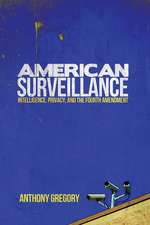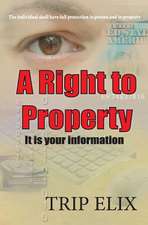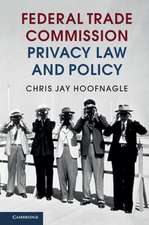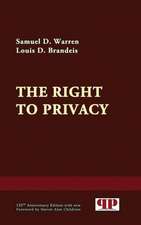What You Need to Know about Privacy Law: A Guide for Librarians and Educators
Autor Gretchen McCorden Limba Engleză Paperback – 22 sep 2013 – vârsta până la 17 ani
Preț: 257.03 lei
Preț vechi: 376.19 lei
-32% Nou
Puncte Express: 386
Preț estimativ în valută:
49.18€ • 53.64$ • 41.47£
49.18€ • 53.64$ • 41.47£
Carte tipărită la comandă
Livrare economică 24 aprilie-08 mai
Preluare comenzi: 021 569.72.76
Specificații
ISBN-13: 9781610690812
ISBN-10: 1610690818
Pagini: 156
Dimensiuni: 178 x 254 x 13 mm
Greutate: 0.34 kg
Ediția:New.
Editura: Bloomsbury Publishing
Colecția Libraries Unlimited
Locul publicării:New York, United States
ISBN-10: 1610690818
Pagini: 156
Dimensiuni: 178 x 254 x 13 mm
Greutate: 0.34 kg
Ediția:New.
Editura: Bloomsbury Publishing
Colecția Libraries Unlimited
Locul publicării:New York, United States
Caracteristici
Organizes and presents information in a fashion that enables readers to think critically and make independent analyses of their specific environment
Notă biografică
Gretchen McCord, MSIS, JD, has been a licensed attorney since 2001, specializing in copyright and privacy law, and is currently a legal consultant and trainer in these areas.
Cuprins
PrefaceAcknowledgmentsPART I: STATE OF THE LAWChapter 1: The Concept and Origins of Privacy Protection in the United StatesWhy Do We Care?History of Privacy as a Legal RightModern Articulation of Privacy ConceptsPersonally Identifiable InformationWhen "Anonymous" Doesn't Mean AnonymousFair Information PracticesChoiceThe International FrontBibliographyChapter 2: Statutory Law Most Pertinent to the Educational ContextFederal StatutesFamily Educational Rights and Privacy Act (FERPA): Protecting Student RecordsThe Protection of Pupil Rights Amendment (PPRA): Gathering Student Information in SurveysNo Child Left Behind Act (NCLB): Undermining FERPAChildren's Online Privacy Protection Act (COPPA): An Attempt to Protect Children OnlineCOPPA and Educational InstitutionsCOPPA's RequirementsElectronic Communications Privacy Act (ECPA): A Few Pieces of the Electronic Privacy Protection PuzzleUSA PATRIOT Act: Has Big Brother Arrived?National Security LettersForeign Intelligence Surveillance Act Court WarrantsAmendments Allow Recipients to ObjectState StatutesCyberbullying, Cyberstalking, and CyberharassmentLibrary RecordsThe Privacy TortsThe Right of PublicityMandatory Reporting of Child AbusePrivacy in Employment LawCase Law and Other AreasBibliographyChapter 3: Constitutional LawFourth Amendment: Reasonable Search and SeizureFirst Amendment: Intertwined with Right of PrivacyTinker v. Des Moines Independent Community School District, 393 U.S. 503 (1969): The Supreme Court Affirms Student Right of Free SpeechBethel School District No. 403 v. Fraser, 478 U.S. 675 (1986): The Constitutional Rights of Students Are Not Automatically Equivalent to Those of AdultsHazelwood School District v. Kuhlmeier, 484 U.S. 260 (1988): Schools May Censor Content of School-Sponsored ActivitiesMorse v. Frederick, 551 U.S. 393 (2007): Schools May Restrict Speech Reasonably Regarded as Encouraging Illegal Drug UseThe Intersection of First Amendment Rights and PrivacyBibliographyChapter 4: Liability under the LawTortWho May Be Held LiableRemediesViolation of Constitutional RightWho May Be Held LiableImmunityRemediesBibliographyPART II: APPLICATIONS IN THE EDUCATIONAL SETTINGChapter 5: Student Privacy in the Brick-and-Mortar WorldReasonable Searches in the Educational ContextStudents Have a Reasonable Expectation of PrivacyThe Standard"Individualized" versus "Generalized" SearchesApplying the StandardSearching Student PossessionsStudent Expectation of Privacy in Belongings Stored on School PropertySearches of Student Dormitory RoomsSearches of Students' PersonsStrip SearchesPhysical Examinations and TestingSearches of Groups of Students and Screening SearchesGenerallySurveillance and Recordings of StudentsDrug DogsDrug Testing of Students Involved in Extracurricular Activities"Seizures": Detaining Students for Questioning and Other ReasonsInvolving Law Enforcement in School Searches and SeizuresEmergencies May Allow Disclosing Student InformationBibliographyChapter 6: Student Privacy OnlineThe Intersection of First and FourthEmail, Social Media, and Cell Phones: Students Have a Reasonable Expectation of PrivacyThe "Special Nature" of Cell Phones and Other Personal Electronic DevicesOff-Campus ActivitiesIntegrating Social Media and Other Interactive Technology into the CurriculumCollecting Student Data and WorksBibliographyChapter 7: Faculty and Staff Rights to PrivacyThe Fourth Amendment and an Employer's Right to Search Employees' ThingsSurveillance of the WorkplaceTelephone ConversationsRecordings of Surveillance: Audio, No; Silent Video, MaybePhysical and Psychological TestingDrug TestingEmployee Rights in the Electronic WorldEmployee's Right to Privacy outside of the Work EnvironmentBibliographyPART III: MOVING FORWARDChapter 8: Privacy PoliciesSteps in Writing a Privacy PolicyConsider Who to Include in the ProcessIdentify the Areas to Be Addressed by the Policy; Specify ConditionsReview Current Policies and Consider Current and Past PracticesContentFinal ReviewsWhat to Do with Your Privacy PolicyGeneral Tips for Writing a Privacy PolicyBibliographyChapter 9: Privacy in a Digital Future: Protecting Our Institutions and Our StudentsEmerging Technologies and the State of Privacy LawWhat Is a Reasonable Expectation of Privacy in the World of Evolving Technology?What Standard Should Determine the Reasonableness of Fourth Amendment Searches and Seizures in a Digital World?Emerging Technologies in the Education ContextThe CloudSocial MediaLocation Tracking TechnologyThe Crystal Ball of Privacy RightsBibliographyChapter 10: Quick and Dirty AnswersGlossaryResources for Further ResearchIndex
Recenzii
This guide is easy to navigate and understand and is up-to-date, which is important in the legal arena. It is recommended primarily for educational institutions.
Accessibly formatted with meaningful headings, a good index, and authoritative citations, McCord's book efficiently leads readers to their applicable concern when faced with ambiguous situations. Strongly recommended.
The work is written in an easy-to-understand style that will make it easy for librarians to decide what information is critical for their library and their patrons. The work provides lists of resources to help educators and librarians stay current. It will be a valuable addition to school library professional collections as well as for teachers, school administrators, and even parents.
Accessibly formatted with meaningful headings, a good index, and authoritative citations, McCord's book efficiently leads readers to their applicable concern when faced with ambiguous situations. Strongly recommended.
The work is written in an easy-to-understand style that will make it easy for librarians to decide what information is critical for their library and their patrons. The work provides lists of resources to help educators and librarians stay current. It will be a valuable addition to school library professional collections as well as for teachers, school administrators, and even parents.













